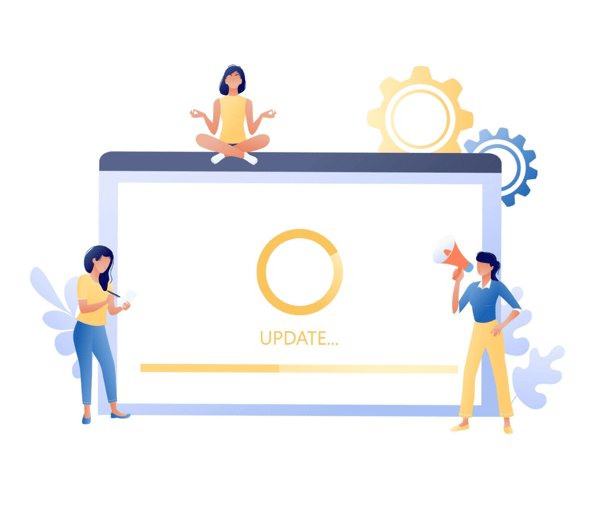
After months of planning, your ERP system is up and running. Congratulations! But keep in mind that making the most of your new ERP solution will not happen on its own. Your post go-live activities and support are important to help you meet your goals and ensure your ERP solution is working for you. Keep reading to see the best practices for avoiding some of the most common post-implementation issues in ERP.
A big part of our job at ERP Advisors Group is to help companies make smart decisions. We guide our clients through the decision making process for an ERP selection and implementation — and we help them recognize what to do and what not to do along the way. A big part of our process includes being there for our clients with post go live support.
An essential part of a successful ERP implementation is the ground work: determining what type of system you need, and the stakeholders who should be involved in the selection and implementation. But these efforts aren’t everything. Once you’ve successfully implemented your system, the next steps you take are just as important.
Here are five tips to help you make the most of your ERP software implementation post go live day:
- Take a break. Unless you are a company that has dedicated some of your staff to your ERP implementation, many of your employees have probably been working overtime on their regular jobs plus the ERP project. ERP implementation projects are intense—no getting around it. Take a break and celebrate everyone’s hard work.
- Spend time with the end users. During the planning phase, the end users should have been integrally involved. Now that the system is up and running, take a look at how those people are using the software and do some post go live testing. Is it working as they thought it would? Are they getting adequate post-implementation support? Do they need more training? Make sure your people are reaping the benefits of the software, and if they are not, spend time figuring out why.
- Look at what needs fixing. A new ERP software system brings with it a new way of doing things. There’s no doubt that this might be uncomfortable for a while. It also might only take a couple of weeks post implementation for users to figure out what else they need that they aren’t getting. Maybe there were a few things that didn’t go into phase one that should have, or perhaps there are processes you assumed users would put into place once the new system was live. This is the time to identify those missed steps and correct them.
- Look for opportunities to automate processes. With an ERP implementation, there are typically three levels: core business processes, more complex processes that add even more value, and top-level processes. This includes reporting, analytics and process automation. After you go live, look at how you can put processes in place to help you do things even better than before. For example, you might want to evaluate key performance indicators regarding days sales outstanding, assess how changes to billing processes impact cash flow, or identify your most and least profitable customers.

- Create your ERP road map. After taking the steps above, we encourage our clients to create a post ERP implementation road map for the future. It should lay out how to fully utilize the ERP and establish a list of best practices. This ensures that the system will be used as intended, and it requires putting a team in place to make sure the software is being put to work. That team should also keep tabs on how key employees acclimate to the new system.
Our job at ERP Advisors Group is to help you select a system that works for your company and meets the needs of your stakeholders, and post-go-live activities is an essential ingredient of any successful ERP implementation. This is when you make sure everyone who needs to use the system feels comfortable doing so — and it is an opportunity to resolve any remaining difficulties or issues. If you skip this key step, you could risk losing the buy-in and support of the team that helped you implement the system initially.
If you need help to optimize your ERP system, assess the effectiveness of your training, are looking for a post go live checklist, or wanting to align your processes with the tools available to you, let us know. We love helping companies enhance their new platforms as much as we enjoy helping them prepare for successful ERP implementation. Click here to schedule a consultation.
Juliette Welch: Hi there, thank you for joining us for today's call: Post Go-Live: How to get the full benefits of your new ERP system.
Shawn Windle is our speaker for today. Shawn is the Founder and Managing Principal of ERP Advisors Group based in Denver, Colorado.
ERP Advisors Group is one of the country's top independent enterprise software advisory firms. ERP Advisors Group advises mid to large sized businesses on selecting and implementing business applications from enterprise resource planning, customer relationship management, human capital management, business intelligence, and other enterprise applications which equate to millions of dollars in software deals each year across many industries.
On today's call, Shawn will discuss how you can get the full benefits of your new ERP system post go-live. Shawn, if you're ready, I'll pass it on to you.
Shawn: Alright. Thanks, Juliette. Thanks everybody for joining, too. If you can mute your lines as well, that would be great.
So, this is a great topic when we look at post go-live. It's an interesting discussion, because a lot of what we do as an organization is help companies get going through what they need and want and selections and then actually doing the implementation. But in actuality, what the entire purpose of all of this work is that you have software that actually runs and does what you need it to do, so this will be fun to talk through, and I'll maybe talk for like 10-15 minutes and give you some of the key pointers for things that we're living through literally as we speak, and some things of what to do and some things of what not to do.
So, let's start with the beginning in mind that there's a big effort to identify what you need for ERP up front. For some of our clients that can be pretty quick, other clients take a while, but you really get everybody’s broad agreement on what we're going to do.
We worked with this services firm recently — and we've actually had two services companies that we're working with where one of them is very much in need of what turned out to be a time and expense and billing and accounting system, whereas the other one, it turns out really just needed accounting.
So, finding out what you need up front is important as well as then getting the agreement from the key stakeholders that we agree this is what we need. That's huge — like that's almost everything. Well, it's actually not because then you have to go select the best fit application. So, we got what we need, we go to the market, we look at the vendors and the apps that are out there, we try to determine which one is the best fit with as much certainty as possible and that alone is a pretty big exercise, but it can be done, and it's being done all over the world as we speak, at least on our projects, hopefully. And then once the client has said this is what we want, we'll negotiate the deal, we'll get things closed, and get all the signatures, and figure out the implementation resources.
Then we implement. And the implementation for enterprise software is kind of like the swallowing the elephant phase. It's hard and it's a lot, and there's a lot of things to consider. And of course, other calls and white papers and blog entries and videos and all that that we have, you can learn tons and tons of best practices and good nuggets to apply there.
But now we're going to take it one step further and say, well, what happens after the implementation? So, that's what post go-live means.
The first thing that needs to happen is this. Take a break. It is really important because usually the team that's been doing the implementation is running very hard with their day job as well as with the implementation.
Now some of our clients that are bigger can afford to have people that are dedicated to a project. Other clients that are smaller can't. So, either way you look at it, the intensity of the implementation is really high. So, the first thing you have to do after you go-live or post go-live after the software is running and people are able to use it, then take a break.
But then what do you do? And this is kind of what the crux of m— I think I'm going to kind of talk through it with this discussion — you really have to, again after you've had a breather from ERP fatigue it's called, is you have to look at how your end users are doing.
So, you put this software in place so that people could run their jobs better if you did it for any other reason — let me think about that, I think that's really true — if you did ERP for any other reason than to alleviate the impact of the business processes upon your people, it's probably not the right reason. Everything that we do goes back to that.
So, you really want to take a look at how are people really doing with the software? So, it's really the most important part of software is the people that are really using the software. Sometimes we have clients that are automating a ton of process and, especially for a real heavy billing company, a company that's doing a ton of billing, they can automate a lot of stuff, which is fantastic, but then you've got users and people that are still looking and doing exceptions and bills that aren't making sense or whatever.
So just make sure find out what those people are up to. How are they doing for real? And make sure that they're still on board with the software and that — the key thing to do with these people is you need to find out what else is needed and wanted now that they're actually using the software and you will find that you were talking to like a Dr. Jekyll and Mr. Hyde.
I always forget which one’s the bad one — I think Mr. Hyde is — and before the implementation you're usually talking to Mr. Hyde, I don't want to change this as terrible is the worst thing ever and I don't want this. Or some people like, yeah I think it's going to be okay, but I'm not really sure. Some people like, yeah, this is going to be great. Usually it's not that up-tone, usually a little down-tone. So, but then after they go-live, after they've been using the system for a bit, after they've been able to see the value, you're usually talking to Doctor Jekyll who's the nice person who can kind of tell you this is great. My life is better and I appreciate it, but there are a couple things that are still broken and I need you to fix them. Great, let's do that.
So, the first thing you do is clean up what is still broken from the first phase. We call this sweeping the glass sometimes, or just simply again, change management around the actual code itself and what's broken and what needs to be fixed. And they're not going to be significant things — we have one client right now where we met with their group, and they basically came back with, the app is too complex, simplify it for us and build in a bunch of controls. Okay, so we did. Then take a look at what the requirements were that you had for phase one that didn't make it in the phase one go-live.
So, typically we'll set out a scope that's sometimes pretty aggressive, and then as you get into it, it's like, oh my gosh, we can't deliver all this, so let's put all those other things that maybe are less important over here to the side and not worry about those until after go-live. So, after go-live you have to worry about those things. So, pick those things back up and make sure that they're still needed and wanted and identify those.
Then you want to look for opportunities to further automate processes that weren't automated in phase one. So, let's say for a financials implementation, we're focusing on kind of core GL, AP, AR, basic stuff. We get that up and running, everybody’s using the software, we give them a break, we found out what was broken in AP with the three-way match process, we get that fixed, maybe we add a couple more nice little enhancements to make it work a little bit better.
Now here we may say, okay, how do we automate the billing side on AR — now that AR is up and running and everything else — how can we really put in this next process that's value-add that will be able to help us to do things better?
And see, that's important because the right way to look at the ERP implementation is — and it's an overused analogy in management consulting but it's really true — is a pyramid that you have three levels that you're really working on with an ERP.
The first level is the core business processes. We want to focus on getting those set. Normally that happens in phase one.
The next level is really on automating more complex processes that are higher value-add. That usually happens in phase two and I would say things like billing, maybe advanced workflow approvals on purchase orders, maybe even really complex intercompany work with multiple entities like really getting into the intercompany consolidation work at the next level. That's what that middle level of the pyramid is.
And then the top level is what it's really all about. And the top level — or the top of this third level is actually kind of small because it's not a lot of money and it's not a lot of time to do it, but that's because you did the base and you did the middle, but the top level is around reporting, analytics, KPI, and really interesting process automation.
So, that is really the crux and the core of what my goal as the guy who has been doing this for 25 years with clients is to get all my clients to that point — some of them never get there, honestly — there's so much benefit with the bottom layer and the middle layer that maybe we don't even get to that top part.
But I'll tell you, if you really ask the people that are willing to stick their necks out on the line to get these software solutions that they really want, they always want what's in the top pyramid. They'll always say things like you have — say a CFO or controller, somebody implementing a financials app —people say, I really want to see what my real KPIs are around days sales outstanding. And I really want to understand how our billings are impacting our cash flow and collections. And what if we really did move to a lock box versus receiving our payments? But what would that really do to cash?
You may even see on the operation side with a wholesale distributor who's looking for their inventory turns, they can do those calculations today, but why are the inventory turns what they are? What does happen when we switch from one vendor to another vendor? Who are not just our top ten vendors or who are not just our top 10 customers — who are our most profitable customers? Who are the vendors that are actually on an overall balanced scorecard? Our worst vendors? There's all these questions that executives really have about how their business operates and they don't get answered in the bottom part of the triangle, nor the middle part — they're always in the in the upper part.
So again, after you go-live, after you've cleaned things up, after you've gotten the requirements that we wanted in phase one — let's get those in phase two — after you looked at other process automations and now you're dealing with these really super high value-add reporting, analytics, KPIs, and robotic process automation, and AI, and all that really wonky stuff that goes in the top part.
That really sets what we call road map — and a lot of other people do, too. I don't like it when people say that's what I call like a road map, well, who doesn't call it that? But it really — we call it a road map that kind of says, here's what we're going to do, when we're going to get it done, and the most important part is who's going to do it.
So, you have to have a definition of priority amongst all these items as well as an understanding of the resources that are required to get this done. And you're going to really have to put a team in place that can maintain and keep this road map going for a while. Now, if you're just doing a simple financials app, that doesn't need to be a big effort there. You might just kind of keep your eye out for the next AICPA regulation that hits you like ASC 606 even though that keeps getting pushed and pushed. That's kind of what the AICPA does, frankly, and the financial accounting standards boards. These guys will put out an announcement, especially FASB as kind of a warning to everybody like this is going to happen in two years. Oh my gosh, what do we do about it?
Well, we hired an advisor and they charged us $400 an hour and they tell us a bunch of stuff already knew. Well, you could do that. Or you can just get everything in order for what you really need, and then know that those FASB regulations are going to get pushed out maybe a couple years like we've seen with several different things of recent — even the new lease accounting policies.
I am a CPA but I need to be very careful because I don't watch those announcements very closely. But it's sort of like the regulatory agencies are saying look, things are going to change, you need to get ready and we know you're not really going to do it until you have to, so we're going to put a really aggressive date out there to make you do it and then we're going to see what our members and people are doing. Anyway, we could do a whole new topic on that, but I don't think anybody would be interested in it.
But you've got to have people in place at post go-live that are actually thinking with — we got this great asset, like let's say it’s a truck. We work with mining companies and they'll spend $5 million on a truck. If they don't have people to maintain that truck and they don't get spare parts for that truck, the truck is going to die. And it's funny, they don't even need drivers anymore — it is wild — some of the things that Caterpillar is doing with these driverless trucks are unbelievable.
But still, somebody has to watch this asset and make sure that they're investing in it appropriately, and that they're getting the return for it, and they're continuously improving it. And that's what we're saying when we say put a team in place is you need a person or multiple people to make sure that your software is moving forward, and there's different levels of people from a technical person, developers, architects, functional people, and that, but the key point is that you have a steward of the application that's helping you move forward — and especially going towards that top of the triangle because that's ultimately what the whole thing is about in terms of value-added.
So, from the summary here, as we said, doing the needs analysis, the selection, and the implementation. We could write a whole book on that, and we're trying to put that together — that's another effort that's on the side for us, but we have many blogs and white papers and everything else that can cover some of the key nuggets there.
There's a lot of work to do there, but the post go-live is really what the whole thing is about; that's why you go through all this effort and spend all this money is that now you have this app and now you can really leverage this and you can think about those three levels of the triangle from the base process automation to more of the medium level complexity stuff to the super complex stuff. But know that that top level is what it's really about. And then do have a steward, a sponsor, a subject matter expert, stakeholder, whatever words you want to use, but somebody who's going to take this thing going forward to make sure that you get the value out of your software that you need.
So, as always, if we can help with anything, let us know. But actually this is one area that all you need to do is call me and we can have like a three minute conversation and be like oh wow, I never thought about doing that, frankly, it's not a really high revenue area for us — these optimizations — but we love, love, love, love, love, love — I could say that for another 10 minutes — to help clients in this area because you've invested so much in us even on the selection process and even in the implementation that we can just do a tiny thing and you can get a ton more benefit on post go-live optimization stuff, so that's it.
Juliette, I'll pass it back to you.
Juliette: Hey thanks Shawn, appreciate that. Thank you again everyone for joining us for today's call as Shawn said, please let us know if you have any questions. We're happy to help in any way we can. Our next call is scheduled for Wednesday, January 15th: Don't let data migration become your ERP roadblock in this next edition of the ERP advisor, we will discuss five data migration “gotchas” and how to handle them so you might tame the data migration beast yourself.
Please go to our website erpadvisorsgroup.com for more details and to register. Thanks again.





